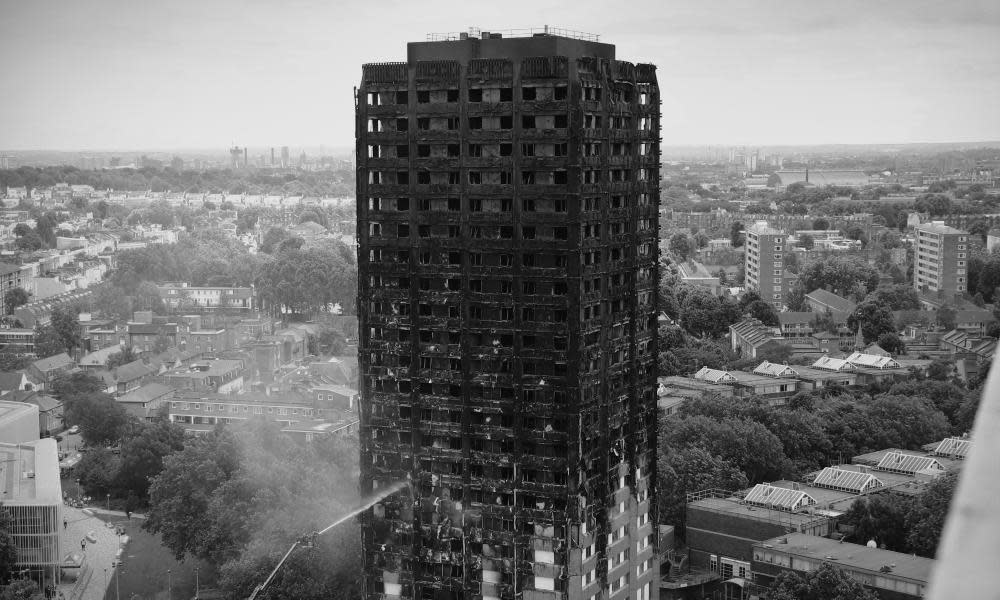Show Me the Bodies: How We Let Grenfell Happen by Peter Apps review – a devastating account of failure

Peter Apps’ book about the Grenfell Tower fire and the subsequent inquiry is an essential work of journalistic scrutiny. The author is deputy editor at Inside Housing and has covered the story meticulously over the past five and a half years. His account is extraordinarily difficult to read, not because his writing isn’t clear and direct throughout – it is – but because Show Me the Bodies is a document not of a tragedy, but of an atrocity.
Overnight on 14 June 2017, 72 people – elderly, middle-aged, young, newborn – died terrifying, yet avoidable, deaths, after a small fire in a single flat spread rapidly to every floor of the west London block. Grenfell had been subject to an unpopular refurbishment a few years earlier which had made the building a death-trap. Its residents knew this, spending years fighting against a “regeneration” of the estate that had prioritised aesthetics and local property values over safety and community.
If they’d been listened to, they would all still be alive. A similar fire, which killed six people at Lakanal House in south London in 2009, should have been enough of a warning, but it wasn’t. Seventy-eight people were killed by a collision of forces with one common root: the broad contempt showed by people with power towards those without it.
Grenfell Tower and Lakanal House were inner-London council blocks housing mainly working-class people of many nationalities, ethnicities and religious backgrounds. Both blocks were refurbished with skewed priorities, at a time of gradual deregulation and the promotion of economic returns above safety. Both were clad in Aluminium Composite Cladding, or ACM, which should never have been approved for high-rise use.
The received wisdom, on which decades’ worth of increasingly threadbare regulation and oversight relied, was that flat fires didn’t spread to other flats, and so high-rise residents were always instructed to “stay put” in the event of an emergency. The introduction of combustible insulation and cladding in flat regeneration programmes made that advice lethal.
Ronnie King, secretary of the All-Party Parliamentary Group on fire safety, which had been pushing for stronger regulation and mandatory sprinkler systems in blocks of flats, was described by Brian Martin, the civil servant effectively in charge of fire safety regulations, as “very annoying … I just ignore him”. Asked at the inquiry what would happen if “somebody who had life safety as their absolute priority” wrote the regulations, Martin memorably said the country would be left “bankrupt” and we would “all starve to death”.
While Martin finally, under extreme pressure at the inquiry, admitted to having had the power to do things differently, Apps is careful to note that “It was, in the end, the system the UK government set up which made him responsible for a policy area on which so many lives depended despite his woeful lack of qualifications … the British state’s consistent inaction for more than 30 years had said it all.”
If you live in a tower block, you get what you’re given, regardless of whether it’s what you need. The people who lived and died in Grenfell Tower needed new lifts, sprinklers and working fire doors, and not – in the words of one survivor – a coat of aspirational “lip gloss”. People such as Sam Webb, the architect and tireless campaigner for tower block safety who died last month, and the Grenfell residents who repeatedly expressed their fears and pressed for accountability that never came, always knew that it came down to class.
Show Me the Bodies will never leave the minds of anyone who reads it. The tragedy is that those who should read it probably won’t.
Show Me the Bodies: How We Let Grenfell Happen by Peter Apps is published by Oneworld (£10.99). To support the Guardian and Observer order your copy at guardianbookshop.com. Delivery charges may apply


